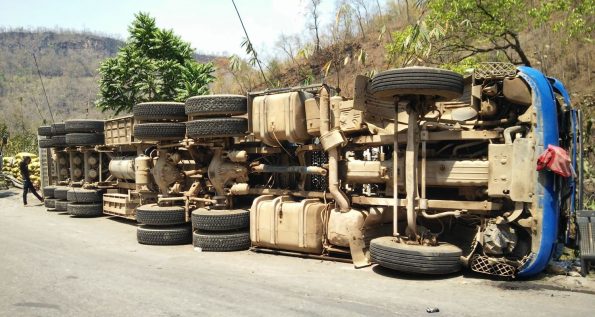If you crash your own car, the costs are fairly straightforward to work out if it’s your fault: if you are insured it’ll be your insurance excess, the loss of your no-claims bonus and maybe a few other minor costs (unless you are seriously injured), and if you’re not insured then you’ll be paying for your vehicle, any other vehicles involved and anything you damage. It can add up to several thousand dollars quite easily, but for a company, an injury crash can be much more severe, especially if the driver has to take a significant time off work.
The amount it costs a company depends on the nature of the work and the type of vehicle damaged and, remember, if a crash costs you $10,000 in expenses and your company’s net profit is 10%, then you’ll need to earn $100,000 extra to cover the costs.

A truck rollover can cause some serious damage to both the vehicle and the freight.
Insurance
The insurance excess on a company car might be $1000, but on a truck or large coach it could be $5000. If you have to claim on your insurance you might lose your no-claims bonus or be forced to take a higher excess.
Then you have to consider what you are carrying. Freight companies will have insurance for the goods they carry, but there could be a separate excess. Companies that use specialist equipment being carried inside the vehicle might need to hold separate insurance for that, which means another excess payable if that equipment is damaged (and damaged equipment then means an interruption to business and revenue).
You might have insurance for business interruption which covers some aspects of loss in relation to not being able to perform work, but often this is limited to your premises, not the loss of a person or vehicle. Besides, it’s yet another excess to pay if you have it.
Lost revenue
The damage to the vehicle and any equipment or goods inside it will cause an interruption for the business, as stated above, so if your employee has to be off work for two weeks, how does that affect your workflow? Can you still deliver to your client’s requirements? Are there any punitive clauses in contracts you have that could cost you if they are not completed on time? If the injured employee is charged out at $100/hr, that’s $4000 in revenue lost every week.
Do you have the resources to fulfil the client work that you’ve got lined up? If you don’t, will this client work disappear to another company and then you could lose that client forever?
Re-staffing or temporary workers
If the injured driver will be away a while it will be worth getting in a temporary contractor to cover the workload, but contractors are more expensive and might not be able to get up-to-speed quickly. Someone also has to find the prospective contractors, interview them, decide on which one is best, induct them, set them up in the payroll system and so on – it’s a massive cost.
Administration
Someone will have to manage the vehicle repairs and organise a replacement. If it’s just a car, it’s straightforward to get a replacement, but if it’s a truck with specialist gear, e.g. pumps or drain laying equipment, then it’s not that easy.
There might be accident reports to deal with, and someone will need to liaise with the client that now won’t either get their work done, or will have lost goods.
How to mitigate the risk of work-related crashes
Make sure your drivers know the road rules. They can practice mock theory tests on our website.
Provide a safe driving policy
Get practical assessments every 2-3 years
Choose safe vehicles – there are technologies that help vehicles avoid collisions.
